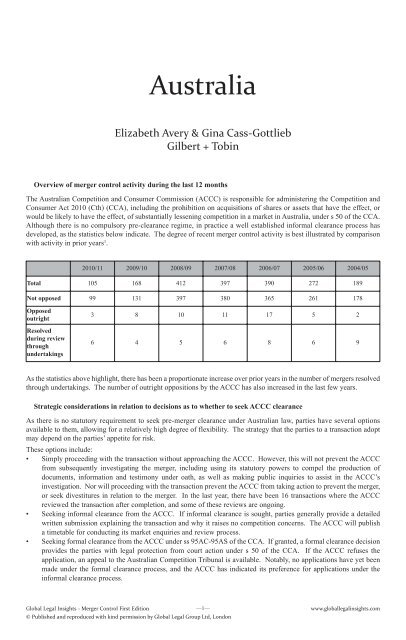Merger Controls First Edition - J Sagar Associates
Merger Controls First Edition - J Sagar Associates
Merger Controls First Edition - J Sagar Associates
You also want an ePaper? Increase the reach of your titles
YUMPU automatically turns print PDFs into web optimized ePapers that Google loves.
Australia<br />
Elizabeth Avery & Gina CassGottlieb<br />
Gilbert + Tobin<br />
Overview of merger control activity during the last 12 months<br />
The Australian Competition and Consumer Commission (ACCC) is responsible for administering the Competition and<br />
Consumer Act 2010 (Cth) (CCA), including the prohibition on acquisitions of shares or assets that have the effect, or<br />
would be likely to have the effect, of substantially lessening competition in a market in Australia, under s 50 of the CCA.<br />
Although there is no compulsory pre-clearance regime, in practice a well established informal clearance process has<br />
developed, as the statistics below indicate. The degree of recent merger control activity is best illustrated by comparison<br />
with activity in prior years1 .<br />
2010/11 2009/10 2008/09 2007/08 2006/07 2005/06 2004/05<br />
Total 105 168 412 397 390 272 189<br />
Not opposed 99 131 397 380 365 261 178<br />
Opposed<br />
outright<br />
Resolved<br />
during review<br />
through<br />
undertakings<br />
3 8 10 11 17 5 2<br />
6 4 5 6 8 6 9<br />
As the statistics above highlight, there has been a proportionate increase over prior years in the number of mergers resolved<br />
through undertakings. The number of outright oppositions by the ACCC has also increased in the last few years.<br />
Strategic considerations in relation to decisions as to whether to seek ACCC clearance<br />
As there is no statutory requirement to seek pre-merger clearance under Australian law, parties have several options<br />
available to them, allowing for a relatively high degree of flexibility. The strategy that the parties to a transaction adopt<br />
may depend on the parties’ appetite for risk.<br />
These options include:<br />
• Simply proceeding with the transaction without approaching the ACCC. However, this will not prevent the ACCC<br />
from subsequently investigating the merger, including using its statutory powers to compel the production of<br />
documents, information and testimony under oath, as well as making public inquiries to assist in the ACCC’s<br />
investigation. Nor will proceeding with the transaction prevent the ACCC from taking action to prevent the merger,<br />
or seek divestitures in relation to the merger. In the last year, there have been 16 transactions where the ACCC<br />
reviewed the transaction after completion, and some of these reviews are ongoing.<br />
• Seeking informal clearance from the ACCC. If informal clearance is sought, parties generally provide a detailed<br />
written submission explaining the transaction and why it raises no competition concerns. The ACCC will publish<br />
a timetable for conducting its market enquiries and review process.<br />
• Seeking formal clearance from the ACCC under ss 95AC-95AS of the CCA. If granted, a formal clearance decision<br />
provides the parties with legal protection from court action under s 50 of the CCA. If the ACCC refuses the<br />
application, an appeal to the Australian Competition Tribunal is available. Notably, no applications have yet been<br />
made under the formal clearance process, and the ACCC has indicated its preference for applications under the<br />
informal clearance process.<br />
Global Legal Insights <strong>Merger</strong> Control <strong>First</strong> <strong>Edition</strong><br />
—1—<br />
© Published and reproduced with kind permission by Global Legal Group Ltd, London<br />
www.globallegalinsights.com


